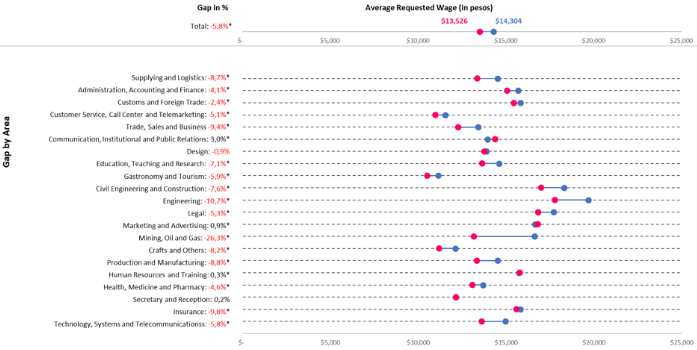The wage gender gap refers to the fact that men often earn more than womenfor doing the same work. This difference may be because men work more hours (an aspect compounded by the fact that they work highly paid overtime), tend to work relatively more in high-pay activities (horizontal gap), prevail in top positions within a company (vertical gap), or are offered higher pay for the same work. Most of these analyses are based on outcomes (actual wages being paid) as it is usually assumed that the gap is driven by a demand bias (Arulampalam et al. 2007, Tijdens and Van Klaveren 2012, Doherty et al. 2017). But to what extent does the gender pay gap reflect an ‘ask gap’? Do women ask for less, for the same exact job?
The literature has identified a variety of factors that can determine gender-driven differences in labour supply. These include gender differences in self-assessments regarding specific occupational choices (Correl 2001) or in the assessment of occupational content (Cortes and Pan 2017, Kleinjans et al. 2017); female preferences for a female-friendly environment (Lordan and Pischke 2016); and lower identification with stereotypically masculine jobs (Barbulescu and Bidwell 2013).
Existing studies on the supply side of the gender gap are based on survey or experimental dataand yield mixed results (Save-Soderbergh 2007, Galperin et al. 2017). An exception is Moreno et al. (2011) who, using data from a national job intermediation service in Perú, find that among indigenous applicants to secretarial positions, females tend to ask for 7% less than males with comparable skills.
In a recent study (González-Rozada and Levy Yeyati 2018), we try to fill this empirical gap by exploiting a new rich dataset containing online asking prices from Navent – ZonaJobs, a large online job application platform in Argentina. The dataset, which includes more than 1.9 million observations of people applying online for different jobs in the Greater Buenos Aires area, involves 5,887 ads, each of which is characterised by the type of job posted (‘title of the ad’), position, and modality of the job (full- or part-time). For each ad, applicants provide a wage bid, as well as information on the applicant´s age and gender. Importantly, no wage or negotiation range is provided by the employer in the job posting. Table 1 summarises the dataset.
Table 1
Note: Authors’ elaboration of data from Navent – ZonaJobs.
We measure the ‘ask’ gender gap by modelling the requested wage for the job as a function of the age and gender of the applicant, all ad-specific characteristics, economic sector, and position level.
Using this base specification, we find that in 79% of the ads, women requested a lower wage than men did: on average, men and women requested AR$14,304 and AR$13,526, respectively, placing the average gender pay gap at a significant -5.8%. Replicating the estimation for each economic sector, we find that in 17 out of the 22 sectors, women ask for a lower average wage than men. The results are statistically significant at the 5% level and range from 1% to 24% (Figure 1).
Figure 1
Note: Authors’ elaboration. Red: women; blue: men. * Statistically significant at 5%.
Is the ‘ask gap’ related to the glass ceiling?1
We estimate our base specification by splitting the sample into five position levels: high management, middle management, senior/semi senior, junior, and other. We find that while, on average, women request a lower wage than men in all positions, the supply-side gender gap increases and becomes substantially larger as we move up the company ladder (Figure 2). The same pattern is revealed when we re-estimate the model by wage quintiles (Figure 3).2
Figure 2
Note: Authors’ elaboration. Red: women; blue: men. * Statistically significant at 5%.
Figure 3
Note: Authors’ elaboration. Red: women; blue: men.* Statistically significant at 5%.
Does the ‘ask gap’ relate to age?
Results in Figure 4 show that the gap virtually disappears for applicants in the 45-64 age group (against gaps of 5% and 6% for age groups 17-24 and 25-44, respectively), which is at odds with the positive correlation with seniority and wage, and suggests that the maternity discount may be internalised by women at the time of bidding for a new job.
Figure 4
Note: Authors’ elaboration. Red: women; blue: men. * Statistically significant at 5%.
Does the gender gap reflect women’s preference for a female-friendly environment?
To shed light on this hypothesis, we test whether the gender gap is wider in male-dominated occupations relative to female-dominated occupations. We define the degree of femininity empirically, based on the female-to-male ratio corresponding to each position and to each sector. More precisely, we rank ads according to their female-to-male ratio, divide the sample in quintiles, and rerun the specification. Figure 5 shows the results. ‘Feminine’ environments command a lower gender gap, a finding theoretically consistent with internalisation by female applicants of gender-specific entry barriers or downward biases in self-assessment when it comes to male-dominated activities.
Figure 5
Note: Authors’ elaboration. Red: women; blue: men.* Statistically significant at 5%.
The same pattern appears across sectors: a higher female-to-male ratio (measured as the number of female-to-male applicants for ads in each sector) is associated with a lower gap (Figure 6). Abstracting for the two obvious outliers (secretarial work, on the far right, and mining oil and gas, at the bottom), there is a significant positive link between the female-to-male ratio and the gender gap.
Figure 6
Conclusion
In sum, we find that:
Women, on average, ask for significantly less wages than men.
- The gap increases with the job position’s ‘level’, which we approximate using the seniority of the position and its average requested wage.
- The gap disappears for women in the 45-64 age range.
- The gap is significantly smaller for female-dominated occupations, as measured by the female-to-male ratio.
While our data is silent about important aspects such as negotiation biases, self-assessment or priors that female and male applicants hold when they apply to a job, our results are consistent with findings in previous work on the gender gap. Our results support the view that women tend to internalise stereotypical characteristics of the actual labour market, as they ask for less wages in situations in which they ultimately are, on average, paid less. The relation between the ‘ask’ and actual pay gaps (e.g. to what extent the former is a reflection or a driver of the latter) remains open to future research.
References
Arulampalam, W, AL Booth, and ML Bryan (2007), “Is there a glass ceiling over Europe? Exploring the gender pay gap across the wage distribution”, ILR Review 60(2): 163-186.
Cortes, P and J Pan (2017), “Occupation and Gender”, IZA Discussion Paper, No. 10672.
Doherty, J, B Levine, D Moldavskaya and K Xiong (2017), “Global gender pay equity: An examination of gaps outside the US”, Mercer Research Paper.
Kleinjans, K, K Krassel and A Dukes (2017), “Occupational prestige and the gender pay gap”, Kyklos 70(4): 565-593.
Galperin, H, G Cruces and C Greppi (2017), “Gender interactions in wage bargaining: Evidence from an online field experiment”, SSRN.
González-Rozada, M and E Levy Yeyati (2018), “Do women ask for lower salaries? The supply side of the gender pay gap”. Working Paper 4/2018, School of Government, Universidad Torcuato Di Tella.
Guvenen, F, G Kaplan and J Song (2014), “The glass ceiling and the paper floor: Gender differences among top earners, 1981-2012”, NBER Working Paper No. 20560.
Livingstone, DW, K Pollock and M Raykov (2016), “Family binds and glass ceilings: Women managers’ promotion limits in a ‘knowledge economy’”. Critical Sociology 42(1): 145-166.
Lordan, G and JS Pischke (2016), “Does Rosie like riveting? Male and female occupational choices”, NBER Working Paper No. 22495.
Moreno, M, H Ñopo and J Saavedra (2011), “Detecting gender and racial discrimination in hiring through monitoring intermediation services: The case of selected occupations in metropolitan Lima, Peru”, World Development Vol. 40(2).
Tijdens, KG and M Van Klaveren (2012), “Frozen in time: Gender pay gap unchanged for 10 years”, ITUC, Brussels.
Endnotes
[1] The glass ceiling denotes the wider gender wage and participation gaps at the top of the career ladder (Guvenen et al. 2014, Livingstone et al. 2016).
[2] To do that, we rank ads by their average requested wage, group ads in quintiles, and rerun our standard specification by quintile.










